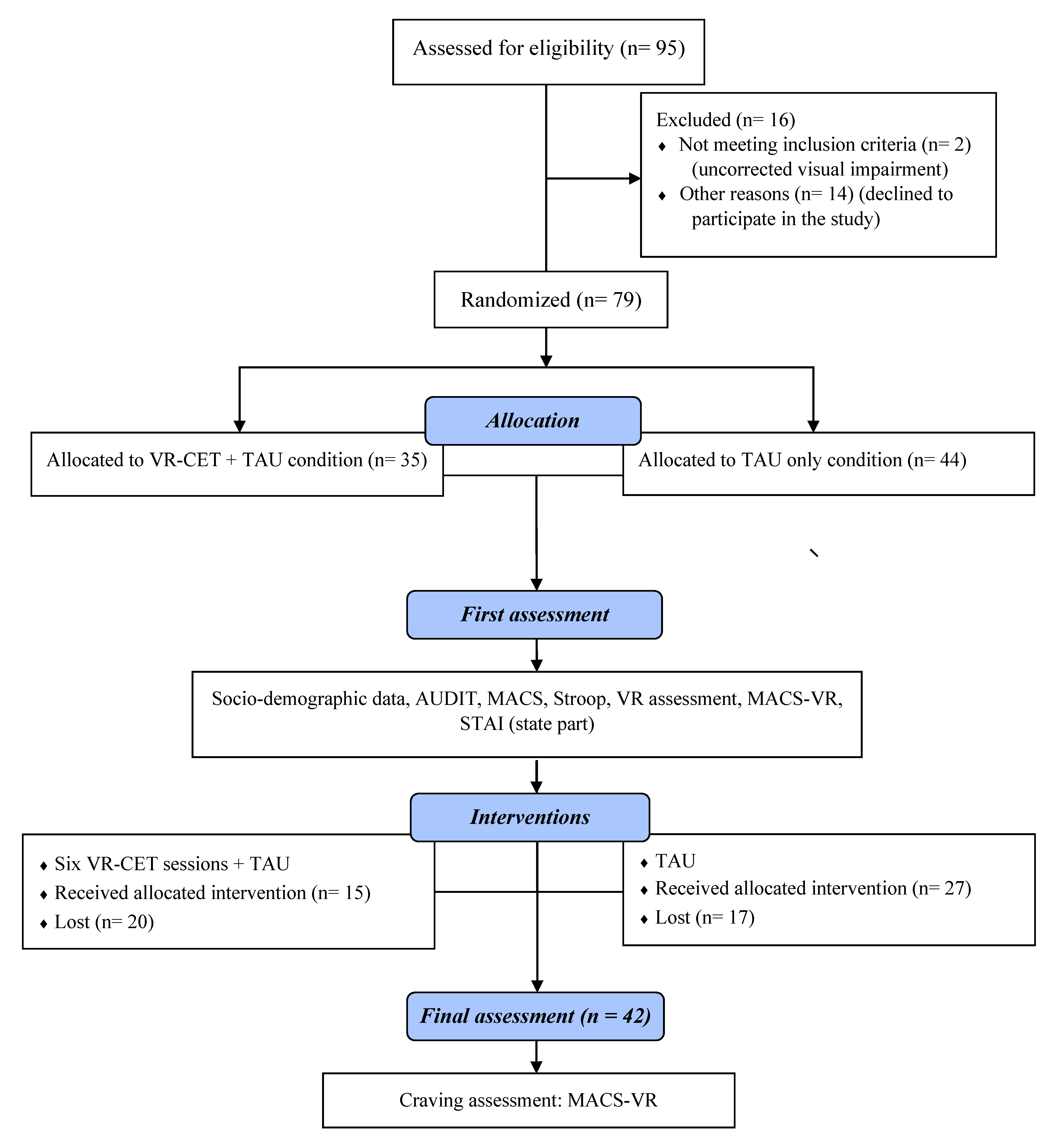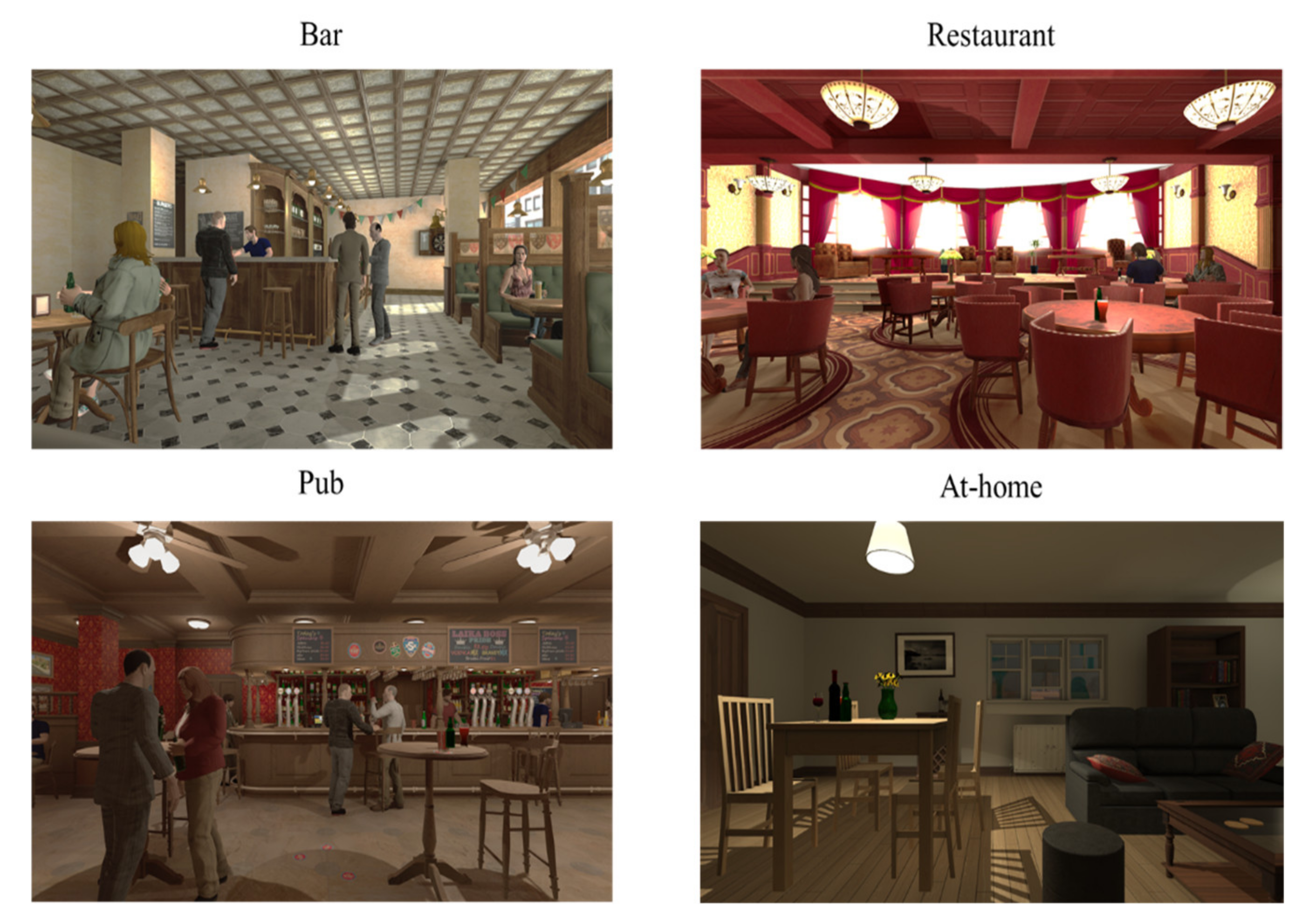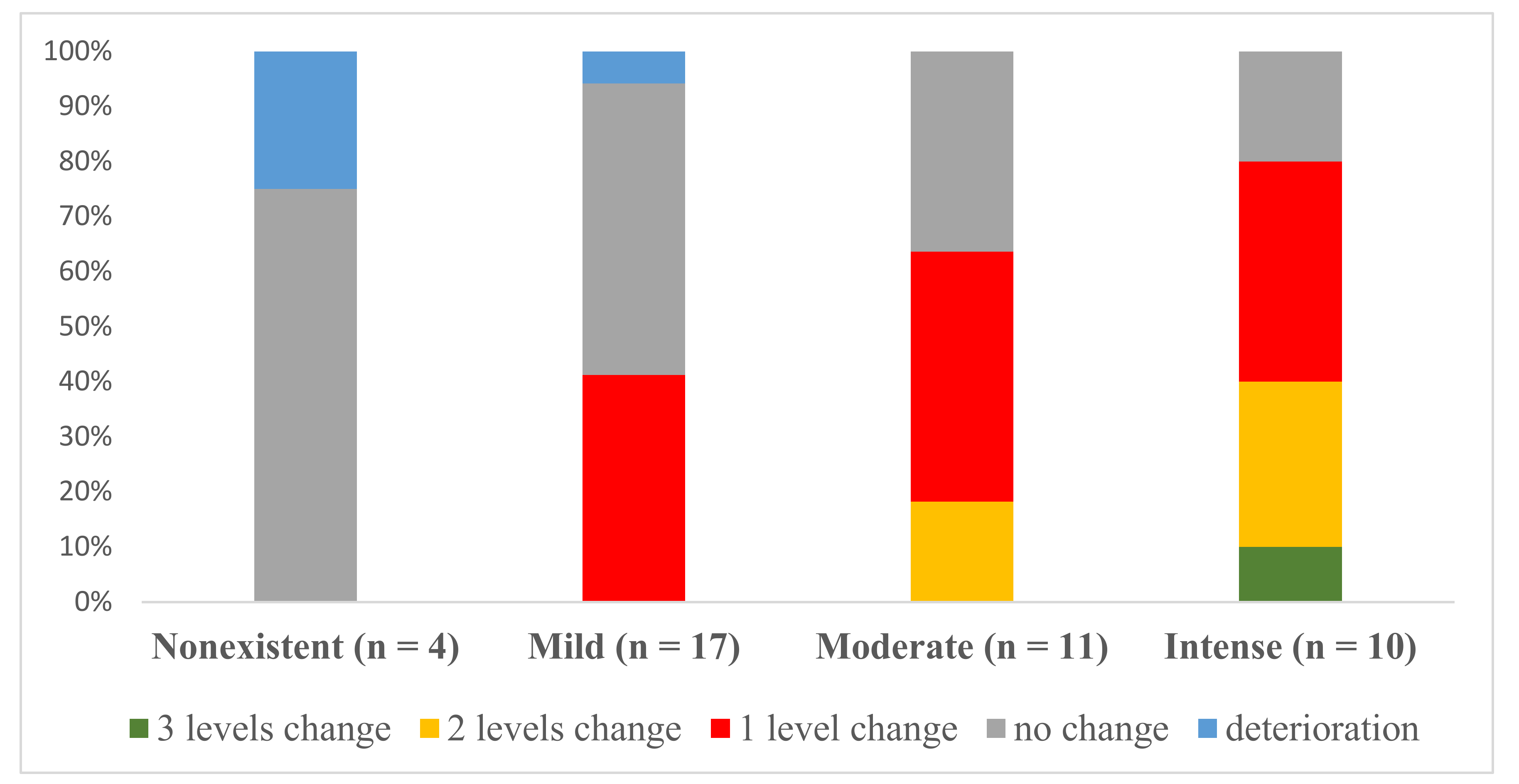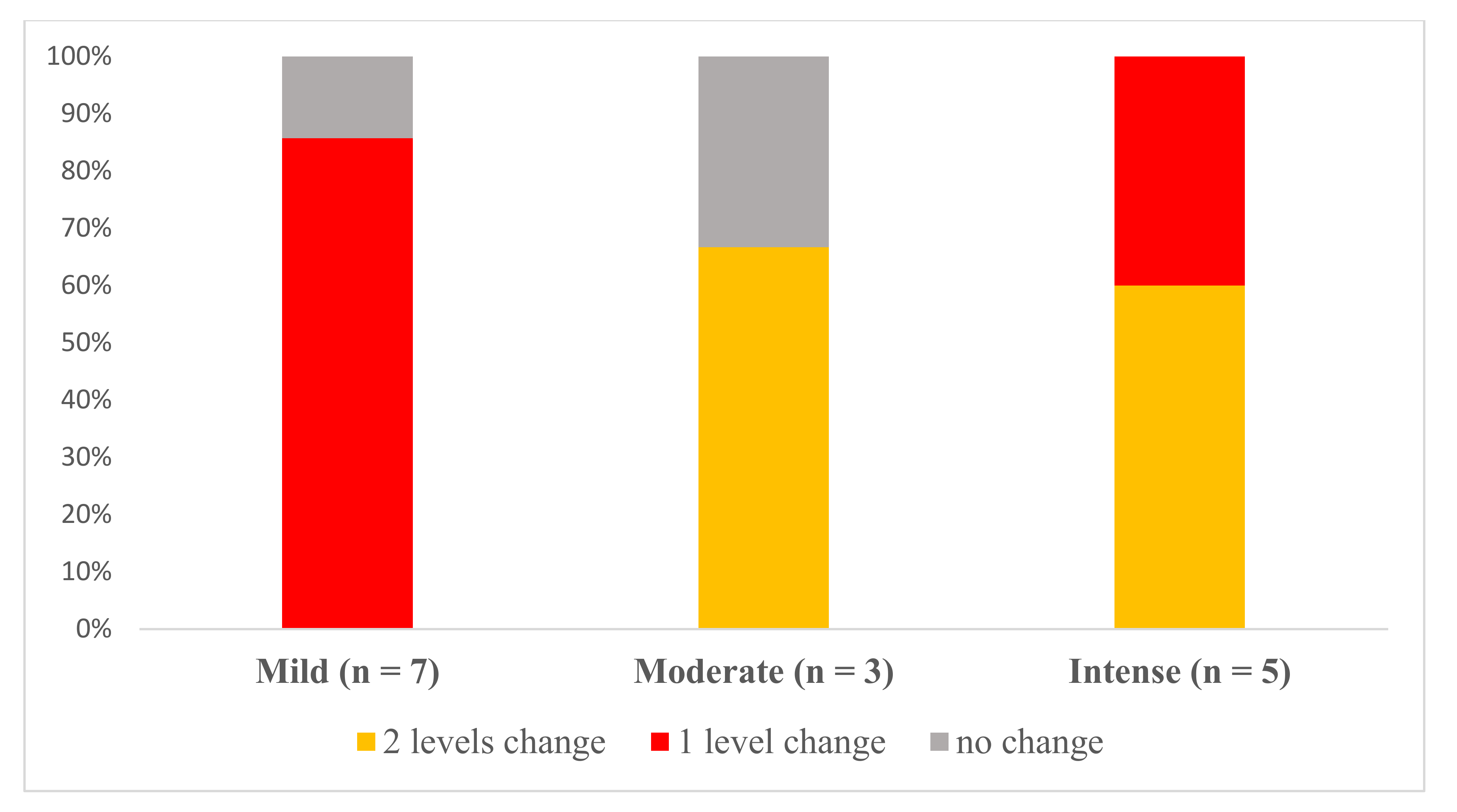Predictors of Changes in Alcohol Craving Levels during a Virtual Reality Cue Exposure Treatment among Patients with Alcohol Use Disorder
Abstract
1. Introduction
2. Methods
2.1. Participants
2.2. Measures
2.3. Instruments
2.3.1. Hardware
2.3.2. Software
2.4. Procedure
2.4.1. Randomization
2.4.2. VR-CET Condition
2.4.3. TAU Condition
2.5. Data Analysis
3. Results
4. Discussion
5. Conclusions
Author Contributions
Funding
Acknowledgments
Conflicts of Interest
References
- Van Lier, H.G.; Pieterse, M.E.; Schraagen, J.M.C.; Postel, M.G.; Vollenbroek-Hutten, M.M.R.; de Haan, H.A.; Noordzij, M.L. Identifying viable theoretical frameworks with essential parameters for real-time and real world alcohol craving research: A systematic review of craving models. Addict. Res. Theory 2018, 26, 35–51. [Google Scholar] [CrossRef]
- Tiffany, S.T.; Wray, J.M. The clinical significance of drug craving. Ann. N. Y. Acad. Sci. 2012, 1248, 1–17. [Google Scholar] [CrossRef]
- Drummond, D.C. Theories of drugs craving, ancient and modern. Addiction 2001, 96, 33–46. [Google Scholar] [CrossRef]
- Snelleman, M. Exploring Factors Related to Craving and Relapse in Alcohol-Dependent Outpatients; Erasmus University Rotterdam: Rotterdam, The Netherlands, 2017. [Google Scholar]
- Stohs, M.E.; Schneekloth, T.D.; Geske, J.R.; Biernacka, J.M.; Karpyak, V.M. Alcohol craving predicts relapse after residential addiction treatment. Alcohol Alcohol. 2019, 54, 167–172. [Google Scholar] [CrossRef]
- Sliedrecht, W.; de Waart, R.; Witkiewitz, K.; Roozen, H.G. Alcohol use disorder relapse factors: A systematic review. Psychiatry Res. 2019, 278, 97–115. [Google Scholar] [CrossRef]
- Breese, G.R.; Sinha, R.; Heilig, M. Chronic alcohol neuroadaptation and stress contribute to susceptibility for alcohol craving and relapse. Pharmacol. Therapeut. 2011, 129, 149–171. [Google Scholar] [CrossRef]
- Morean, M.E.; L’Insalata, A.; Butler, E.R.; McKee, A.; Krishnan-Sarin, S. Age at drinking onset, age at first intoxication, and delay to first intoxication: Assessing the concurrent validity of measures of drinking initiation with alcohol use and related problems. Addict. Behav. 2018, 79, 195–200. [Google Scholar] [CrossRef] [PubMed]
- Hintzen, A.K.; Cramer, J.; Karagülle, D.; Heberlein, A.; Frieling, H.; Kornhuber, J.; Bleich, S.; Hillemacher, T. Does alcohol craving decrease with increasing age? Results from a cross-sectional study. J. Stud. Alcohol Drugs 2011, 72, 158–162. [Google Scholar] [CrossRef] [PubMed]
- Rohit, S.R.; Shwetha, R.; Bhat, S. Factor analysis of coping strategies among subjects of alcohol dependence syndrome: A study at tertiary care center. J. Alcohol. Drug Depend. 2017, 5, 1–7. [Google Scholar]
- Petit, G.; Luminet, O.; Cordovil de Sousa Uva, M.; Monhonval, P.; Leclercq, S.; Spilliaert, Q.; Zammit, F.; Maurage, P.; de Timary, P. Gender differences in affects and craving in alcohol-dependence: A study during alcohol detoxification. Alcohol. Clin. Exp. Res. 2017, 41, 421–431. [Google Scholar] [CrossRef]
- Yarmush, D.E.; Manchery, L.; Luehring-Jones, P.; Erblich, J. Gender and impulsivity: Effects on cue-induced alcohol craving. Alcohol. Clin. Exp. Res. 2016, 40, 1052–1067. [Google Scholar] [CrossRef]
- Day, A.M.; Celio, M.A.; Lisman, S.A.; Spear, L.P. Gender, history of alcohol use and number of drinks consumed predict craving among drinkers in a field setting. Addict. Behav. 2014, 39, 1–11. [Google Scholar] [CrossRef] [PubMed]
- Rosoff, D.B.; Clarke, T.K.; Adams, M.J.; McIntosh, A.M.; Smith, G.D.; Jung, J.; Lohoff, F.W. Educational attainment impacts drinking behaviors and risk for alcohol dependence: Results from a two-sample Mendelian randomization study with ~780,000 participants. Mol. Psychiar. 2019, 1–19. [Google Scholar] [CrossRef]
- Cronce, J.M.; Larimer, M.E. Individual-focused approaches to the prevention of college student drinking. Alcohol. Res. Health 2011, 34, 210–221. [Google Scholar]
- Walton, M.A.; Blow, F.C.; Bingham, C.R.; Chermack, S.T. Individual and social/environmental predictors of alcohol and drug use 2 years following substance abuse treatment. Addict. Behav. 2003, 28, 627–642. [Google Scholar] [CrossRef]
- De Sousa Uva, M.C.; Luminet, O.; Cortesi, M.; Constant, E.; Derely, M.; de Timary, P. Distinct effects of protracted withdrawal on affect, craving, selective attention and executive functions among alcohol-dependent patients. Alcohol Alcohol. 2010, 45, 241–256. [Google Scholar] [CrossRef]
- Manchery, L.; Yarmush, D.E.; Luehring-Jones, P.; Erblich, J. Attentional bias to alcohol stimuli predicts elevated cue-induced craving in young adult social drinkers. Addict. Behav. 2017, 70, 14–27. [Google Scholar] [CrossRef]
- Balsamo, D.N.; Douaihy, A.; Cornelius, J.R.; Daley, D.; Kirisci, L.; Hyman, S.M.; Salloum, I.M. Differential impact of depressive and manic mood states on alcohol craving in comorbid bipolar alcoholism: Preliminary findings. Addict. Disord. Their Treat. 2016, 15, 107–112. [Google Scholar] [CrossRef]
- Fatseas, M.; Serre, F.; Swendsen, J.; Auriacombe, M. Effects of anxiety and mood disorders on craving and substance use among patients with substance use disorder: An ecological momentary assessment study. Drug. Alcohol Depend. 2018, 187, 242–248. [Google Scholar] [CrossRef]
- Lane, S.P.; Carpenter, R.W.; Sher, K.J.; Trull, T.J. Alcohol craving and consumption in borderline personality disorder: When, where, and with whom. Clin. Psychol. Sci. 2016, 4, 775–792. [Google Scholar] [CrossRef]
- Simpson, T.L.; Stappenbeck, C.A.; Varra, A.A.; Moore, S.A.; Kaysen, D. Symptoms of posttraumatic stress predict craving among alcohol treatment seekers: Results of a daily monitoring study. Psychol. Addict. Behav. 2012, 26, 724–735. [Google Scholar] [CrossRef] [PubMed]
- Piasecki, T.M.; Jahng, S.; Wood, P.K.; Robertson, B.M.; Epler, A.J.; Cronk, N.J.; Rohrbaugh, J.W.; Heath, A.C.; Shiffman, S.; Sher, K.J. The subjective effects of alcohol-tobacco co-use: An ecological momentary assessment investigation. J. Abnorm. Psychol. 2011, 120, 557–571. [Google Scholar] [CrossRef] [PubMed]
- Cooney, N.L.; Litt, M.D.; Cooney, J.L.; Pilkey, D.T.; Steinberg, H.R.; Oncken, C.A. Alcohol and tobacco cessation in alcohol-dependent smokers: Analysis of real-time reports. Psychol. Addict. Behav. 2007, 21, 277–286. [Google Scholar] [CrossRef] [PubMed]
- Hitschfeld, M.J.; Schneekloth, T.D.; Ebbert, J.O.; Hall-Flavin, D.K.; Karpyak, V.M.; Abulseoud, O.A.; Patten, C.A.; Geske, J.R.; Frye, M.A. Female smokers have the highest alcohol craving in a residential alcoholism treatment cohort. Drug. Alcohol Depend. 2015, 150, 179–182. [Google Scholar] [CrossRef]
- Karriker-Jaffe, K.J.; Subbaraman, M.S.; Greenfield, T.K.; Kerr, W.C. Contribution of alcohol and drug co-use to substance use problems: Data from a nationally-representative sample of US adults who have never been to treatment. Nord. Stud. Alcohol Drugs 2018, 35, 428–442. [Google Scholar] [CrossRef]
- Hallgren, K.A.; Mccrady, B.S.; Epstein, E.E. Trajectories of drinking urges and the initiation of abstinence during cognitive-behavioral alcohol treatment. Addiction 2016, 111, 854–865. [Google Scholar] [CrossRef]
- Law, B.; Gullo, M.J.; Daglish, M.; Kavanagh, D.J.; Feeney, G.F.X.; Young, R.M.; Connor, J.P. Craving mediates stress in predicting lapse during alcohol dependence treatment. Alcohol. Clin. Exp. Res. 2016, 40, 1058–1064. [Google Scholar] [CrossRef]
- Bottlender, M.; Soyka, M. Impact of craving on alcohol relapse during, and 12 months following, outpatient treatment. Alcohol Alcohol. 2004, 39, 357–361. [Google Scholar] [CrossRef]
- Yoon, G.; Kim, S.W.; Thuras, P.; Grant, J.E.; Westermeyer, J. Alcohol craving in outpatients with alcohol dependence: Rate and clinical correlates. J. Stud. Alcohol Drugs 2006, 67, 770–777. [Google Scholar] [CrossRef]
- Litt, M.D.; Cooney, N.L.; Morse, P. Reactivity to alcohol-related stimuli in the laboratory and in the field: Predictors of craving in treated alcoholics. Addiction 2000, 95, 889–900. [Google Scholar] [CrossRef]
- Bujarski, S.; David Jentsch, J.; Roche, D.J.O.; Ramchandani, V.A.; Miotto, K.; Ray, L.A. Differences in the subjective and motivational properties of alcohol across alcohol use severity: Application of a novel translational human laboratory paradigm. Neuropsychopharmacology 2018, 43, 1891–1899. [Google Scholar] [CrossRef] [PubMed]
- MacKillop, J.; Miranda, R., Jr.; Monti, P.M.; Ray, L.A.; Murphy, J.G.; Rohsenow, D.J.; McGeary, J.E.; Swift, R.M.; Tidey, J.W.; Gwaltney, C.J. Alcohol demand, delayed reward discounting, and craving in relation to drinking and alcohol use disorders. J. Abnorm. Psychol. 2010, 119, 106–114. [Google Scholar] [CrossRef] [PubMed]
- Wapp, M.; Burren, Y.; Znoj, H.; Moggi, F. Association of alcohol craving and proximal outcomes of a residential treatment program for patients with alcohol use disorders. J. Subst. Use 2015, 20, 11–15. [Google Scholar] [CrossRef]
- Connor, J.P.; Jack, A.; Feeney, G.F.X.; Young, R.M.D. Validity of the Obsessive-Compulsive Drinking Scale in a heavy drinking population. Alcohol. Clin. Exp. Res. 2008, 32, 1067–1073. [Google Scholar] [CrossRef] [PubMed]
- Anker, J.J.; Kummerfeld, E.; Rix, A.; Burwell, S.J.; Kushner, M.G. Causal Network Modeling of the determinants of drinking behavior in comorbid alcohol use and anxiety disorder. Alcohol. Clin. Exp. Res. 2018, 43, 91–97. [Google Scholar] [CrossRef] [PubMed]
- McCaul, M.E.; Hutton, H.E.; Stephens, M.A.C.; Xu, X.; Wand, G.S. Anxiety, anxiety sensitivity, and perceived stress as predictors of recent drinking, alcohol craving, and social stress response in heavy drinkers. Alcohol. Clin. Exp. Res. 2017, 41, 836–845. [Google Scholar] [CrossRef] [PubMed]
- Quintana, D.S.; Guastella, A.J.; McGregor, I.S.; Hickie, I.B.; Kemp, A.H. Heart rate variability predicts alcohol craving in alcohol dependent outpatients: Further evidence for HRV as a psychophysiological marker of self-regulation. Drug Alcohol Depend. 2013, 132, 359–398. [Google Scholar] [CrossRef]
- Kavanagh, D.J.; Statham, D.J.; Feeney, G.F.X.; Young, R.M.D.; May, J.; Andrade, J.; Connor, J.P. Measurement of alcohol craving. Addict. Behav. 2013, 38, 1572–1584. [Google Scholar] [CrossRef]
- Schlauch, R.C.; Gwynn-Shapiro, D.; Stasiewicz, P.R.; Molnar, D.S.; Lang, A.R. Affect and craving: Positive and negative affect are differentially associated with approach and avoidance inclinations. Addict. Behav. 2013, 38, 1970–1979. [Google Scholar] [CrossRef]
- Simon, J.; Etienne, A.M.; Bouchard, S.; Quertemont, E. Alcohol craving in heavy and occasional alcohol drinkers after cue exposure in a virtual environment: The role of the sense of presence. Front. Hum. Neurosci. 2020, 14, 124. [Google Scholar] [CrossRef]
- Mellentin, A.I.; Skøt, L.; Nielsen, B.; Schippers, G.M.; Nielsen, A.S. Cue exposure therapy for the treatment of alcohol use disorders: A meta- analytic review. Clin. Psychol. Rev. 2017, 57, 195–207. [Google Scholar] [CrossRef] [PubMed]
- Ferrer-García, M.; Gutiérrez-Maldonado, J.; Pla-Sanjuanelo, J.; Vilalta-Abella, F.; Riva, G.; Clerici, M.; Ribas-Sabaté, J.; Andreu-Gracia, A.; Fernandez-Aranda, F.; Forcano, L.; et al. A randomised controlled comparison of second-level treatment approaches for treatment-resistant adults with bulimia nervosa and binge eating disorder: Assessing the benefits of virtual reality cue exposure therapy. Eur. Eat. Disord Rev. 2017, 25, 479–490. [Google Scholar] [CrossRef] [PubMed]
- Mellentin, A.I.; Nielsen, B.; Nielsen, A.S.; Yu, F.; Stenager, E. A randomized controlled study of exposure therapy as aftercare for alcohol use disorder: Study protocol. BMC Psychiatry 2016, 16, 112. [Google Scholar] [CrossRef] [PubMed]
- Ghiţă, A.; Gutiérrez-Maldonado, J. Applications of virtual reality in individuals with alcohol misuse: A systematic review. Addict. Behav. 2018, 81, 1–11. [Google Scholar] [CrossRef]
- Maples-Keller, J.L.; Bunnell, B.E.; Kim, S.-J.; Rothbaum, B.O. The use of Virtual Reality technology in the treatment of anxiety and other psychiatric disorders. Harv. Rev. Psychiatry 2017, 25, 103–113. [Google Scholar] [CrossRef]
- Du Sert, O.P.; Potvin, S.; Lipp, O.; Dellazizzo, L.; Laurelli, M.; Breton, R.; Lalonde, P.; Phraxayavong, K.; O’Connor, K.; Pelletier, J.F.; et al. Virtual reality therapy for refractory auditory verbal hallucinations in schizophrenia: A pilot clinical trial. Schizophr. Res. 2019, 197, 176–181. [Google Scholar] [CrossRef]
- Ferrer-García, M.; Gutiérrez-Maldonado, J. The use of virtual reality in the study, assessment, and treatment of body image in eating disorders and nonclinical samples: A review of the literature. Body Image 2012, 9, 1–11. [Google Scholar] [CrossRef]
- Ferrer-Garcia, M.; Pla-Sanjuanelo, J.; Dakanalis, A.; Vilalta-Abella, F.; Riva, G.; Fernandez-Aranda, F.; Forcano, L.; Riesco, N.; Sánchez, I.; Clerici, M.; et al. A randomized trial of virtual reality-based cue exposure second-level therapy and cognitive behavior second-level therapy for bulimia nervosa and binge-eating disorder: Outcome at six-month follow up. Cyberpsychol. Behav. Soc. Netw. 2018, 22, 60–68. [Google Scholar] [CrossRef]
- Segawa, T.; Baudry, T.; Bourla, A.; Blanc, J.V.; Peretti, C.S.; Mouchabac, S.; Ferreri, F. Virtual reality (VR) in assessment and treatment of addictive disorders: A systematic review. Front. Neurosci. 2019, 13, 1409–1423. [Google Scholar] [CrossRef]
- Lee, S.H.; Han, D.H.; Oh, S.; Lyoo, I.K.; Lee, Y.S.; Renshaw, P.F.; Lukas, S.E. Quantitative electroencephalographic (qEEG) correlates of craving during virtual reality therapy in alcohol-dependent patients. Pharmacol. Biochem. Behav. 2009, 91, 393–397. [Google Scholar] [CrossRef]
- Lee, J.H.; Kwon, H.; Choi, J.; Yang, B.H. Cue-exposure therapy to decrease alcohol craving in virtual environment. Cyberpsychol. Behav. 2007, 10, 617–623. [Google Scholar] [CrossRef] [PubMed]
- Son, J.H.; Lee, S.H.; Seok, J.W.; Kee, B.S.; Lee, H.W.; Kim, H.J. Virtual reality therapy for the treatment of alcohol dependence: A preliminary investigation with positron emission tomography/computerized tomography. J. Stud. Alcohol Drugs 2015, 76, 620–627. [Google Scholar] [CrossRef] [PubMed]
- Ghiţă, A.; Hernández-Serrano, O.; Fernández-Ruiz, Y.; Monras, M.; Ortega, L.; Mondon, S.; Teixidor, L.; Gual, A.; Porras-García, B.; Ferrer-García, M.; et al. Cue-elicited anxiety and alcohol craving as indicators of the validity of ALCO-VR software: A Virtual Reality study. J. Clin. Med. 2019, 8, 1153. [Google Scholar] [CrossRef]
- American Psychiatric Association. Diagnostic and Statistical Manual of Mental Disorders, 5th ed.; DSM-5; American Psychiatric Association: Arlington, VA, USA, 2013. [Google Scholar]
- Contel Guillamón, M.; Gual Solé, A.; Colom Farran, J. Test para la identificación de trastornos por uso de alcohol (AUDIT): Traducción y validación del AUDIT al catalán y castellano. Adicciones 1999, 11, 337–347. [Google Scholar] [CrossRef]
- Babor, T.F.; Ramon De La Fuente, J.; Saunders, J.; Grant, M. The Alcohol Use Disorders Identification Test: Guidelines for Use in Primary Health Care; World Health Organization: Geneve, Switzerland, 2001. [Google Scholar]
- Donovan, D.M.; Kivlahan, D.R.; Doyle, S.R.; Longabaugh, R.; Greenfield, S.F. Concurrent validity of the Alcohol Use Disorders Identification Test (AUDIT) and AUDIT zones in defining levels of severity among out-patients with alcohol dependence in the COMBINE study. Addiction 2006, 101, 1696–1704. [Google Scholar] [CrossRef]
- Guardia Serecigni, J.; Segura García, L.; Gonzalvo Cirac, B.; Trujols Albet, J.; Tejero Pociello, A.; Suárez González, A.; Gil, A.M. Estudio de validación de la Escala Multidimensional de Craving de Alcohol. Med. Clin. 2004, 123, 211–216. [Google Scholar] [CrossRef]
- Sánchez-López, A.; Quinto-Guillen, R.; Pérez-Lucas, J.; Jurado-Barba, R.; Martínez-Grass, I.; Ponce-Alfaro, G.; Rubio-Valladolid, G. Validación de la versión española del Test Stroop de Alcohol. An. Psicol. 2015, 31, 504–523. [Google Scholar]
- Spielberger, C.D.; Gonzalez-Reigosa, F.; Martinez-Urrutia, A.; Natalicio, L.F.S.; Natalicio, D.S. Development of the Spanish Edition of the State-Trait Anxiety Inventory. Interam. J. Psychol. 1971, 5, 145–158. [Google Scholar]
- Ghiţă, A.; Teixidor, L.; Monras, M.; Ortega, L.; Mondon, S.; Gual, A.; Paredes, S.M.; Villares Urgell, L.; Porras-García, B.; Ferrer-García, M.; et al. Identifying triggers of alcohol craving to develop effective virtual environments for cue exposure therapy. Front. Psychol. 2019, 10, 74. [Google Scholar] [CrossRef]
- Suresh, K.P. An overview of randomization techniques: An unbiased assessment of outcome in clinical research. J. Hum. Reprod. Sci. 2011, 4, 8–11. [Google Scholar] [CrossRef]
- Ferrer-García, M.; García-Rodríguez, O.; Pericot-Valverde, I.; Yoon, J.H.; Secades-Villa, R.; Gutiérrez-Maldonado, J. Predictors of smoking craving during virtual reality exposure. Presence 2012, 21, 423–434. [Google Scholar] [CrossRef]
- Monterosso, J.R.; Flannery, A.A.; Pettinati, M.; Oslin, D.W.; O’b Rien, C.P.; Volpicelli, J.R. Predicting treatment response to naltrexone: The influence of craving and family history. Am. J. Addict. 2001, 10, 258–268. [Google Scholar]
- Jaffe, A.J.; Rounsaville, B.; Chang, G.; Schottenfeld, R.S.; Meyer, R.E.; O’Malley, S.S. Naltrexone, relapse prevention, and supportive therapy with alcoholics: An analysis of patient treatment matching. J. Consult. Clin. Psychol. 1996, 64, 1044–1053. [Google Scholar] [CrossRef] [PubMed]
- Suzuki, S.; Mell, M.M.; O’Malley, S.S.; Krystal, J.H.; Anticevic, A.; Kober, H. Regulation of craving and negative emotion in alcohol use disorder. Biol. Psychiatry Cogn. Neurosci. 2020, 5, 239–250. [Google Scholar] [CrossRef] [PubMed]
- Robles-Martínez, M.; García-Carretero, M.Á.; Gibert Rahola, J.; Rodríguez-Cintas, L.; Palma-Álvarez, R.F.; Abad, A.C.; Sorribes, M.; Torrens, M.; Roncero, C. Relationship between craving and impulsivity in patients with alcohol dependence with or without dual disorders in an outpatient treatment center: A descriptive study. Actas Esp Psiquiatr. 2019, 47, 88–96. [Google Scholar] [PubMed]
- Papachristou, H.; Nederkoorn, C.; Corstjens, J.; Jansen, A. The role of impulsivity and perceived availability on cue-elicited craving for alcohol in social drinkers. J. Psychopharmacol. 2012, 224, 145–153. [Google Scholar] [CrossRef][Green Version]
- Forsyth, J.P.; Parker, J.D.; Finlay, C.G. Anxiety sensitivity, controllability, and experiential avoidance and their relation to drug of choice and addiction severity in a residential sample of substance-abusing veterans. Addict. Behav. 2003, 28, 851–870. [Google Scholar] [CrossRef]
- Westerberg, V.S. Constituents of craving in a clinical alcohol sample. J. Subst. Use 2000, 12, 415–423. [Google Scholar] [CrossRef]
- Anton, R.F. What Is craving? Models and implications for treatment. Alcohol Res. Health 1999, 23, 165–174. [Google Scholar]
- De Timary, P.; Cordovil de Sousa Uva, M.; Denoël, C.; Hebborn, L.; Derely, M.; Desseilles, M.; Luminet, O. The associations between self-consciousness, depressive state and craving to drink among alcohol dependent patients undergoing protracted withdrawal. PLoS ONE 2013, 8, e71560. [Google Scholar] [CrossRef]
- Ceccarini, J.; Leurquin-Sterk, G.; Crunelle, C.L.; de Laat, B.; Bormans, G.; Peuskens, H.; Van Laere, K. Recovery of decreased metabotropic glutamate receptor 5 availability in abstinent alcohol-dependent patients. J. Nucl. Med. 2020, 61, 256–262. [Google Scholar] [CrossRef] [PubMed]
- European Monitoring Centre for Drugs and Drug Addiction. Polydrug Use: Patterns and Responses; EMCDDA: Luxembourg, 2009. [Google Scholar]
- Hernández-Serrano, O.; Gras, M.E.; Font-Mayolas, S.; Sullman, M.J.M. Types of polydrug use. In Neutopathology of Drug Addictions and Substance Misuse; Elsevier Academic-Press: London, UK, 2016; pp. 839–849. [Google Scholar]
- McBride, D.; Barrett, S.P.; Kelly, J.T.; Aw, A.; Dagher, A. Effects of expectancy and abstinence on the neural response to smoking cues in cigarette smokers: An fMRI study. Neuropsychopharmacology 2006, 31, 2728–2738. [Google Scholar] [CrossRef] [PubMed]
- Conklin, C.A.; Robin, N.; Perkins, K.A.; Salkeld, R.P.; McClernon, F.J. Proximal versus distal cues to smoke: The effects of environments on smokers’ cue-reactivity. Exp. Clin. Psychopharmacol. 2008, 16, 207–214. [Google Scholar] [CrossRef] [PubMed]
- Conklin, C.A. Environments as cues to smoke: Implications for human extinction-based research and treatment. Exp. Clin. Psychopharmacol. 2006, 14, 12–19. [Google Scholar] [CrossRef] [PubMed]
- Brorson, H.H.; Arnevik, E.A.; Rand-Hendriksen, K.; Duckert, F. Drop-out from addiction treatment: A systematic review of risk factors. Clin. Psychol. Rev. 2013, 33, 1010–1024. [Google Scholar] [CrossRef] [PubMed]
- Lappan, S.N.; Brown, A.W.; Hendricks, P.S. Dropout rates of in-person psychosocial substance use disorder treatments: A systematic review and meta-analysis. Addiction 2020, 115, 201–217. [Google Scholar] [CrossRef]





| N (%) or Mean ± SD | N or Mean ± SD | Comparison TAU vs. TAU+VR-CET | |||
|---|---|---|---|---|---|
| Characteristics | Total Sample (n = 42) | Improvement in AC (n = 22) | No Change or Deterioration (n = 20) | p Value | p Value |
| Age | 54.60 ± 7.71 | 52.91 ± 7.74 | 56.45 ± 7.42 | 0.474 | 0.576 |
| Gender (female) | 21 (50.0%) | 13 | 8 | 0.354 | 1.000 |
| Education | 0.617 | 0.657 | |||
| Elementary school | 0 (0.0%) | 0 | 0 | ||
| High school | 17 (40.5%) | 9 | 8 | ||
| Junior college Associate degree | 9 (21.4%) | 6 | 3 | ||
| University | 15 (35.1%) | 6 | 9 | ||
| Master‘s degree | 1 (2.4%) | 1 | 0 | ||
| Socioeconomic status | 0.449 | 0.271 | |||
| Low | 6 (14.3%) | 4 | 2 | ||
| Medium | 35 (83.3%) | 17 | 18 | ||
| High | 1 (2.4%) | 1 | 0 | ||
| Civil status | 0.116 | 0.571 | |||
| Single | 5 (11.9%) | 1 | 4 | ||
| Married/in a relationship | 19 (45.2%) | 8 | 11 | ||
| Separated/divorced | 13 (31.0%) | 9 | 4 | ||
| Widower | 5 (11.9%) | 4 | 1 | ||
| AUD severity | 16.95 ± 9.96 | 18.55 ± 11.15 | 15.20 ± 8.40 | 0.068 | 0.572 |
| Abstinence duration (days) | 98.52 ± 113.72 | 93.95 ± 109.96 | 103.55 ± 120.38 | 0.975 | 0.538 |
| Psychiatric comorbidity | 22 (52.4%) | 11 | 11 | 0.746 | 1.000 |
| Types of psychiatric comorbidity | 0.133 | 0.199 | |||
| No comorbidity | 20 (47.6%) | 11 | 9 | ||
| DD | 12 (28.6%) | 3 | 9 | ||
| DD + AD | 2 (4.8%) | 1 | 1 | ||
| DD + AD + PD | 3 (7.1%) | 2 | 1 | ||
| AD | 2 (4.8%) | 2 | 0 | ||
| PD | 3 (7.1%) | 3 | 0 | ||
| State anxiety | 18.47 ± 11.37 | 18.40 ± 11.32 | 18.55 ± 11.72 | 0.710 | 0.326 |
| Attentional bias | 15.36 ± 13.15 | 13.36 ± 13.94 | 17.55 ± 12.20 | 0.560 | 0.491 |
| Current smoker | 25 (59.5%) | 15 | 10 | 0.546 | 0.531 |
| Use of Illicit drugs | 15 (35.7%) | 13 | 2 | 0.001 | 0.325 |
| Type of treatment | 0.001 | NA | |||
| TAU + VR-CET | 15 (35.7%) | 18 | 9 | ||
| TAU | 27 (64.3%) | 2 | 13 | ||
| Characteristics | B | O.R. (95%CI) | p Value |
|---|---|---|---|
| Type of treatment | −2.899 | 0.055 (0.008–0.386) | 0.004 * |
| Illicit drugs | −2.899 | 0.055 (0.008–0.386) | 0.004 * |
© 2020 by the authors. Licensee MDPI, Basel, Switzerland. This article is an open access article distributed under the terms and conditions of the Creative Commons Attribution (CC BY) license (http://creativecommons.org/licenses/by/4.0/).
Share and Cite
Hernández-Serrano, O.; Ghiţă, A.; Figueras-Puigderrajols, N.; Fernández-Ruiz, J.; Monras, M.; Ortega, L.; Mondon, S.; Teixidor, L.; Gual, A.; Ugas-Ballester, L.; et al. Predictors of Changes in Alcohol Craving Levels during a Virtual Reality Cue Exposure Treatment among Patients with Alcohol Use Disorder. J. Clin. Med. 2020, 9, 3018. https://doi.org/10.3390/jcm9093018
Hernández-Serrano O, Ghiţă A, Figueras-Puigderrajols N, Fernández-Ruiz J, Monras M, Ortega L, Mondon S, Teixidor L, Gual A, Ugas-Ballester L, et al. Predictors of Changes in Alcohol Craving Levels during a Virtual Reality Cue Exposure Treatment among Patients with Alcohol Use Disorder. Journal of Clinical Medicine. 2020; 9(9):3018. https://doi.org/10.3390/jcm9093018
Chicago/Turabian StyleHernández-Serrano, Olga, Alexandra Ghiţă, Natàlia Figueras-Puigderrajols, Jolanda Fernández-Ruiz, Miquel Monras, Lluïsa Ortega, Silvia Mondon, Lidia Teixidor, Antoni Gual, Lidia Ugas-Ballester, and et al. 2020. "Predictors of Changes in Alcohol Craving Levels during a Virtual Reality Cue Exposure Treatment among Patients with Alcohol Use Disorder" Journal of Clinical Medicine 9, no. 9: 3018. https://doi.org/10.3390/jcm9093018
APA StyleHernández-Serrano, O., Ghiţă, A., Figueras-Puigderrajols, N., Fernández-Ruiz, J., Monras, M., Ortega, L., Mondon, S., Teixidor, L., Gual, A., Ugas-Ballester, L., Fernández, M., Montserrat, R., Porras-Garcia, B., Ferrer-Garcia, M., & Gutiérrez-Maldonado, J. (2020). Predictors of Changes in Alcohol Craving Levels during a Virtual Reality Cue Exposure Treatment among Patients with Alcohol Use Disorder. Journal of Clinical Medicine, 9(9), 3018. https://doi.org/10.3390/jcm9093018








